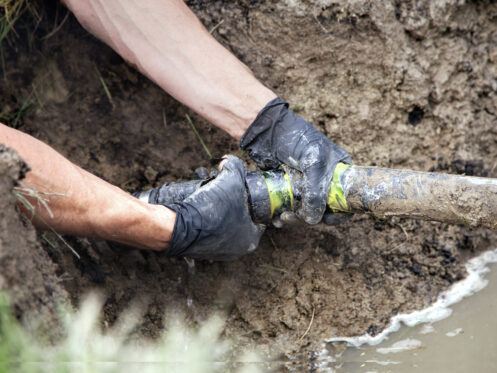A sewer line backup is more than an inconvenience; it can be a full-blown crisis for any homeowner. Not only can it render your plumbing system useless, but a backup can also pose health risks and cause significant property damage. Knowing the right steps to take can minimize these problems and get your home back to normal as quickly as possible. While you may feel tempted to handle it yourself, consulting with professionals like us at Laury Heating Cooling & Plumbing is crucial to assess and resolve the situation properly. So, what should you do when you’re faced with a sewer line backup?
1. Avoid Using Plumbing Fixtures
The moment you suspect or confirm that your sewer line has backed up, it’s imperative to cease using all plumbing fixtures in your home immediately. Continuing to run water or flush toilets will likely exacerbate the problem, pushing the backup into other areas of your home. This means you should halt any ongoing dishwasher or washing machine cycles and refrain from using sinks and toilets until a professional has assessed the situation.
Stopping the use of plumbing fixtures serves multiple purposes. First, it helps prevent additional wastewater from entering the backed-up sewer line, which could lead to more severe flooding and property damage. Second, it minimizes health risks by reducing the chance of sewage water contaminating other areas of your home. Until a professional from Laury Heating Cooling & Plumbing can manage the issue, it’s best to hold off on using any plumbing fixtures to mitigate any further complications.
2. Turn Off the Main Water Supply
A sewer line backup is a situation no homeowner wants to face. When such an event occurs, water continues to flow through pipes and can further aggravate the problem, leading to increased water damage and the potential spread of contaminants. This is why it’s crucial to act swiftly by shutting off the main water supply to your home. Doing so effectively halts the water flow, preventing it from adding to the backup. The main water valve is typically located in a utility room, basement, or close to where the primary water line enters your home.
Turning off the main water supply might seem simple, but it’s a powerful preventative measure in a sewer line emergency. Not only does it curtail further damage, but it also prepares your home for the professional intervention that will follow. Once you’ve ensured no more water can contribute to the issue, you’ve taken a significant step toward damage control. Meanwhile, it allows experts from Laury Heating Cooling & Plumbing to work efficiently upon arrival, focusing on resolving the main issue rather than battling with ongoing water flow.
3. Assess the Extent of the Problem
When you notice a sewer line backup, you must gauge the extent of the issue quickly. Observe which areas in your home are affected; is it a single room or multiple rooms? This initial evaluation can provide valuable insights into the problem’s seriousness. Knowing whether the backup is localized to one area or more widespread will help determine the urgency and type of professional assistance required. Your observations will be crucial for the experts to understand the situation better and provide an effective solution.
Accurate assessment is not just for your peace of mind; it’s vital information for the professionals who will eventually tackle the problem. If the issue is contained in one area, the problem could be related to a specific fixture or pipe, which might mean a quicker fix. On the other hand, a widespread issue might indicate a more severe problem that may require extensive intervention. In either case, your initial assessment is a key part of the process that helps in the overall resolution.
4. Keep Children and Pets Away
When dealing with a sewer line backup, your priority should always be the health and safety of your household. During such backups, the water and waste that invade your home are laden with harmful bacteria and potential toxins. For this reason, it’s imperative to immediately keep the most vulnerable, including children and the elderly, away from the affected areas. Having a designated safe zone in parts of the house untouched by the backup ensures they’re not at risk of coming into contact with the contaminated water.
It’s not just about physical contact. The odors and airborne particles from the backup can be harmful when inhaled. Children and pets, curious by nature, might not understand the dangers and could venture into affected areas, putting their health at risk. Ensuring they are kept at a safe distance, ideally in an entirely different part of the house, helps avoid any accidental exposure and grants you peace of mind as you handle the situation.
5. Ventilate the Area
Ventilating the affected areas during a sewer line backup is not just about combating the unpleasant smells; it’s a matter of health and safety. Sewage backups can release harmful bacteria and toxins into the air. Opening windows and doors will help circulate fresh air into the space, effectively diluting these harmful elements. Using fans, if available, can also expedite the process of air circulation, helping to clear out lingering odors and potentially hazardous particles.
Additionally, good ventilation helps in creating a more bearable environment for anyone who needs to enter the affected area, especially professionals who will work on resolving the issue. Efficient airflow can assist in reducing the concentration of noxious fumes and airborne contaminants, making it safer and more comfortable for everyone. While ventilation can’t solve the problem, it certainly makes the situation more manageable as you await professional help.
6. Contact Your Insurance Company
When you’re dealing with something as disruptive and potentially expensive as a sewer line backup, one of your first calls should be to your insurance company. You’ll need to determine whether your homeowner’s insurance policy covers this issue. Filing a claim as soon as possible can help you financially and allow you to focus on resolving the problem rather than worrying about the costs. While it may seem like a hassle, properly documenting the damage through photos and notes can make the claim process much smoother.
The urgency in contacting your insurance company also lies in their often stringent requirements for timely reporting such incidents. The quicker you contact them and provide all the necessary details, the more likely your claim will be processed without hitches. Gathering evidence like professional estimates, photographs, and a list of damaged items can strongly support your claim. It’s better to be thorough from the get-go, as this helps expedite the claims process and gets you back to normal life faster.
7. Call a Professional Service
When facing a sewer line backup, you need to involve professionals who can diagnose and tackle the problem efficiently. Even if you’re handy around the house, a sewer line issue is something to handle with specialized skills and equipment. Professionals have the training to assess the situation quickly, determine the cause of the backup, and develop a plan of action. This saves you time and ensures that the problem is adequately resolved, mitigating any health risks involved.
Moreover, professional services can provide you with something invaluable: peace of mind. Knowing that trained experts are handling your sewer line backup allows you to focus on other aspects, like family safety and coordinating with your insurance company. They’ll also sanitize the affected areas, which is vital for the well-being of your household. Additionally, these experts can offer guidance on preventative measures, ensuring you’re less likely to face the same problem in the future. Learn more about the process we take for unclogging a sewer line here!
If you’re dealing with a sewer line backup in South Jersey, remember you’re not alone. At Laury Heating Cooling & Plumbing, we’re more than just sewer problem solvers; we’re your one-stop shop for heating, AC installation, repair, and various plumbing services. When life throws you curveballs like this, it’s good to have a go-to team you can trust. Reach out to Laury Heating Cooling & Plumbing today and let us help you get your home back to normal.



